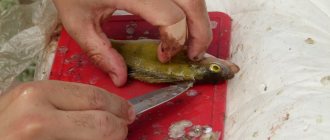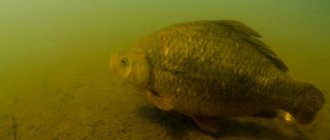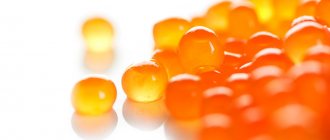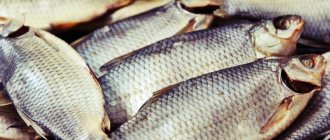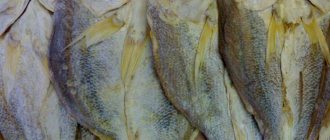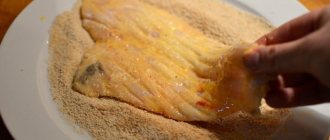Features of carp
What kind of carp are you preparing? There are several types of this fish:
- mirror carp;
- Thai;
- Japanese;
- ordinary freshwater.
Delicious fish in salted, smoked, stewed, even boiled form. Use it if you want to enrich the body with iodine, phosphorus, antioxidants, and also improve metabolism, the functioning of brain cells and protect health from cancer. Carp dishes are an excellent option for those who are on a diet.
Carp is the same as carp, only the former can be bred independently, for example, in ponds on a suburban area. The fish is large, weighing three or more kilograms. The most delicious meat comes from individuals weighing 2-3 kg. Carp is a fatty fish and its content during artificial breeding can be regulated using diet.
Choosing a tool for cleaning carp
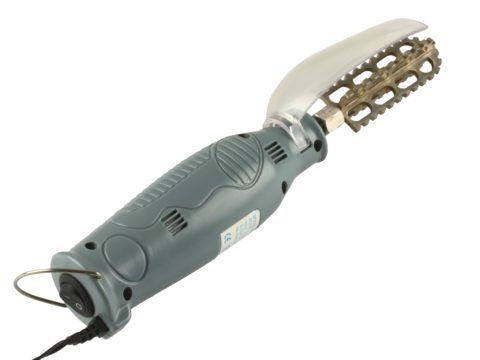
A variety of tools are used to facilitate the labor of purification. Use a sharp knife or fish scaler. In camping conditions, homemade devices made from glass bottle caps will help - they can be nailed to a wooden base, or an ordinary tin can - make holes from the inside with a nail.
Inexperienced housewives, those who are afraid of cutting themselves, can arm themselves with a spoon or fork - pry up the scales with them and remove them with a digging motion against their growth from the head, gradually moving towards the tail. Buy a vegetable peeler with a longitudinal blade or a special scraper. These are safe and effective tools. If the fish is very large, it is more convenient to cut it in the bathroom. Use scissors to remove fins.
Fish cleaning equipment
If you or your family are fish lovers, you should get special tools for cleaning it. They will significantly facilitate and speed up the work process.
It is worth paying attention to the following devices:
- fish scaler or scraper;
- board with clamps;
- kitchen scissors;
- tweezers;
- fillet knife.
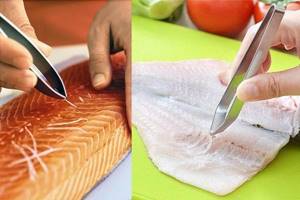
With a fish scaler or scraper you can clean not just one, but several fish carcasses in a matter of minutes. In this case, the scales will not fly apart. Kitchen scissors are very convenient for cutting off fins. A board with clamps is needed to fix the carcass, tweezers are needed to remove bones from the fillet. A fillet knife is for cutting meat from the bone. When you use it, nothing will remain on the bones, and the fillet seems even larger than the fish itself.
Fish scaler or fish cleaning knife
When cleaning fish, the tool is of great importance. To prevent the scales from flying, he must easily separate them without damaging the skin. There are many types of special tools: from knives to scrapers and electric fish scalers.

A regular paring knife has large serrations on the blade. It is not as convenient as scrapers, which also collect scales in a special bowl.

Fish cleaning board
It's no secret that you need to have a separate board for fish. It is best to purchase a special board with clamps for cleaning and cutting. The clothespin helps to fix the carcass, as a result of which it does not slip or move out.

Of all the varieties, the most practical is a plastic board with a corrugated surface. It does not absorb odors, unlike wood products.
Fish cleaning clamp
If you already have a fish board and don’t intend to part with it, you can purchase a clamp separately. Clips for cleaning fish are made of stainless steel and are relatively cheap - about 100 rubles. Install the clamp on the board and you will no longer worry about the fish slipping out.
Homemade device
You can make a tool for cleaning fish yourself from a piece of tin or a tin can. If you drill holes in them, sharp jagged edges will separate the scales. Attach the tip to a wooden spatula or block - and a complete device for cleaning fish is ready. Or you can make it even simpler - attach beer caps or an old grater to the blade with self-tapping screws. Example in the photo:

Preparing fresh fish
If you bought carp from an aquarium in a store, ask the sellers to properly cut the live carp. They provide such a service. When you bring home an uncut carcass, it is covered in mucus. It is difficult to hold such an individual in your hands. Rinse it under water - problem solved. Also, the water will soak the scales, making it easier to remove. If you get a large representative, pour boiling water over it. Be sure to cut off the fins before you begin removing the scales. They are sharp and can injure your hands. You are lucky if you choose a mirror carp; it is not completely covered with scales and is easy to clean.
Removing scales

We begin to remove the stratum corneum. Use the tools we talked about earlier. To prevent scales from flying all over the kitchen, fill a sufficiently sized container with water and carry out the procedure in it. You can protect your kitchen with a regular bag. Place the fish in a bag. Work so that the debris remains inside the cellophane.
Dip the carcass in boiling water for no more than one minute; you can quickly clean it.
For adherents of traditional methods, you can simply place the fish on a cutting board and clean off the scales with a knife from the tail to the head; at the end of the work, do not forget to wash the kitchen well.
How to clean a carcass from scales using the “removal of chain mail” method
Prepare a sharp butcher (with a long blade). Use it to pry the scales at the base of the tail, but do not damage the skin. Cut off the scales by moving the tool towards the head. In the place near the head where the scales are connected to the bone, make a cut - this is how you get chain mail. Do the same on the other side.
How to clean different types of fish?
The cleaning method largely depends on the type of fish. Some species have scales so small and soft that they are left behind. Other fish are cleaned of scales, removing them along with the skin. Before you clean and cut up a fish for the first time, you need to familiarize yourself with its features.
We recommend: How to make clear ice without bubbles at home?
How to clean pike perch?
Pike perch is a very tasty and healthy freshwater fish of the perch family. It is distinguished by hard scales. In addition, it has sharp dorsal fins that can easily injure your hands. Therefore, the first thing is to always cut them off, and then fix the pike perch on a cutting board and clean off the scales with a fish scaler, a special knife or a household device. This is the case when, for easy cleaning, it will be useful to use one of the life hacks: scalding with boiling water, cleaning under water.
How to clean pink salmon?
Pink salmon has small and soft scales. However, they need to be removed even if you plan to simply salt the fish.
How to clean pink salmon from scales quickly and effectively?
- Place the fish in the refrigerator for half an hour. Clean the frozen carcass when it is half defrosted. Try not to wet pink salmon.
- Grasp the tail and lightly scratch the fish towards the head. Do not use much force to prevent the scales from flying apart.
After cleaning, the fins are cut off and the gills are removed. If necessary, you can remove the skin using a thin and long fillet knife, prying it off at the tail. They also use it to fillet fish.
How to clean mackerel?
Mackerel is one of those rare fish that does not require cleaning before cooking. Instead of scales, it has a thin skin, which, as a rule, is not removed. You just need to cut off the fins, separate the head and remove the giblets, and then cut it up at your discretion.
How to clean pollock?
Pollock is a very popular sea fish. It is affordable, healthy, contains minimal bones and is very easy to clean. Its scales are so small and delicate that many do not notice them at all. But it is still correct to clean the pollock before cooking. To do this, remove the sharp fins, and then, holding the carcass by the tail, scrape off the scales against the growth. It is best to clean pollock when slightly frozen under running water.
How to clean carp?
Carp is an artificially bred fish, domesticated carp. Its meat has a sweetish taste and is highly valued in cooking. The fish has a large, tight-fitting skin, but is easy to clean:
- Dip the carp into water acidified with vinegar (dry scales do not easily come off the skin).
- Use scissors to cut off all fins except the tail fin.
- Insert your finger under the gills to secure the carcass.
- Use the thumb of your other hand to get under the scales near the tail.
- Move it smoothly under the scales, moving towards the fish's head.
- Do the same on the opposite side. The scales will be easy to remove without scattering to the sides.
Also in cooking, scales are often removed along with the skin. To do this you need a long and thin knife with a point. They penetrate under the skin of the fish at the tail part and carefully move along the entire length. Then the layer of skin is cut off. The procedure is repeated until all the skin is removed.
How to remove gills from carp?
When cooking fish with the head, the eyes and gills must be removed. To do this, use a sharp knife - and nothing more.
To properly remove gills from carp and other fish, follow this algorithm:
- Lift the operculum.
- Stick a knife inside
- Make deep cuts from the side of the ridge on one side and the other of the head.
- Cut the gills where they join the abdomen.
- Pull it towards you and take it out.
The gills are the easiest way to determine the freshness of fish: they are the first to spoil. If they are dense and reddish in color, then the fish is fresh.
How to clean crucian carp?
A river fish that everyone knows. Crucian carp makes excellent fish soup. And if you make cuts on the cleaned and cut up carcasses, then during frying all the small bones will soften and will be imperceptible.
Just like carp, crucian carp is cleaned with your fingers:
- Place the crucian carp in a deep bowl of water.
- Cut off the fins.
- Grasp the gills.
- Using your thumb, pry the scales off the tail.
- Brush it off, moving towards the head.
We recommend: Are thyme and thyme the same thing? Where to add the magic herb?
Despite the fact that the scales of crucian carp are large, they are quite soft and easily separated from the skin.
How to clean and cut trout?
Cleaning trout does not take much time. The scales of the fish are quite small and do not tend to fly apart. Usually it is scraped off with the blunt side of a knife, holding the fish by the tail. To prevent it from slipping, sprinkle your hands with salt or wrap the carcass with a paper napkin. Then the fish is washed and cut.
Trout can be cut in different ways depending on the cooking method:
- Roasting a whole carcass. The fish's fins are trimmed. Then a shallow incision is made from the anus to the gill. Take out the insides. Remove the black film. The gills are removed. Rinse under running water.
- Fillet, for sushi and salads. After removing the fins from the small fish, remove the skin in the manner of a stocking, picking it up at the head. Then they gut and fillet the fish. Large trout are first gutted, the head is cut off, and then the fillet and skin are removed, making a neat cut from the side of the ridge. The skin can be removed later using a fillet knife.
How to clean a dorado?
Dorado fish is also called sea carp. Most often there is no need to clean fish from scales - it is sold already cleaned. But if you come across a specimen with scales, do the following:
- Cut the fins off the carcass.
- Place the dorado in a large basin.
- Grab the tail and scrape off the scales directly under water (with a knife or special device).
- Remove the entrails, gills, or entire head.
The sea fish has a light belly, on which the scales are hardly noticeable. Nevertheless, it is there. Give this area plenty of attention.
How to clean bream?
Bream is a very tasty river fish. But like many other freshwater species, it is covered with dense large scales. To remove it, you have to make an effort, which can cause the scales to fly around the room. It is best to clean bream in a bag, under water or by scalding with boiling water. A fish scaler with a cup will also come in handy here, as it will simultaneously clean and collect scales.
Dried fish begin to be cleaned by removing the fin on the back. It is pulled out, and then an incision is made along the length of the ridge and the skin along with the scales is carefully removed. Then all that remains is to separate the head and take out the insides of the fish.
How to clean carp?
Carp is a common carp. The fish has darker golden scales and an elongated body. Perhaps this is one of the most difficult fish to clean: the scales are very large, dense and do not want to separate from the surface.
It is better to entrust the cleaning of the carp to a man, leaving him alone with the fish in the bathroom. If this option is not possible, we recommend removing the scales along with the skin (see Cleaning carp).
The fresher the river fish, the easier it is to clean. The best way to do this is while fishing.
Recommendations
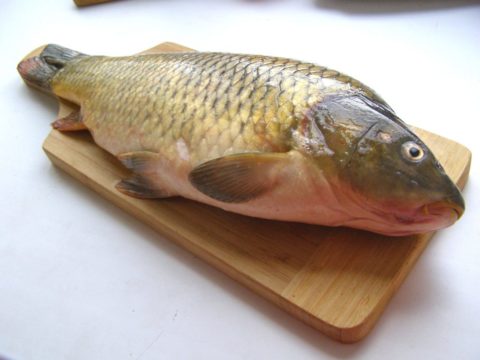
Some tips will help inexperienced housewives prepare fish correctly and not spoil the dish. In cooking, sometimes little things can significantly affect the taste of a dish. If you cook whole, remove the gills and eyes. Do the same if you are going to cook fish soup from heads and tails. Place the remaining fish in cold water - this will make the broth richer, and put the valuable meat at the end of cooking, then it will retain its beneficial properties.
If you have to clean frozen carp, defrost it first. To preserve the beneficial substances found in meat, use a salt solution - a teaspoon per kilogram of fish. Place the product in it and wait until it defrosts. Defrosting in hot water is strictly not recommended; the quality of the meat will suffer. To speed up the process, put the carp in a bag, check that it is intact and that no water has gotten into it. The fish in the bag can be placed in a container with warm water. This way the meat won’t lose its density and you won’t have to wait long.
Carp meat has high nutritional properties. Easy and completely digestible, but not everyone likes to clean it. Now any housewife can properly clean carp at home. If you need to clean a carp, our recommendations will help. After all, carp and carp are similar breeds. Perhaps our advice will help you and a once difficult task will become a breeze. Whatever way you clean your fish, do it with love. Anything will bring pleasure to you and your loved ones.
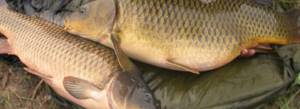
Cleaning and cutting carp is a simple process, although unpleasant. But after you turn your “fresh catch” into a culinary masterpiece that will delight your family, you will no longer be bothered by the presence of scales, blood and giblets while working on a dish of very healthy and incredibly tasty fish.
Features and value of carp
Carp is an artificially bred species of fish, the ancestor of which is the carp. The word "carp" comes from the Greek language and is translated as fruit. And for good reason: one female produces up to 1.5 million eggs. The Chinese were the first to breed domesticated carp. Historians believe that this fish began to be used as food back in 1000 BC. e. Carp dishes became a favorite treat for Chinese emperors. Later, fish began to be bred in other Asian countries and Europe.
Carp meat has great benefits for the body. It is very tender and sweetish in taste. The fat content of fish muscle tissue is lower than that of lean beef, which is important for people on a low-fat diet, as well as for children and athletes. Carp is a source of many important nutrients, proteins and omega-3 fatty acids. These unsaturated acids have a positive effect on cardiac function and help prevent cardiovascular diseases. Another feature of carp is its ease of digestibility, due to the special structure of muscle fibers.
It takes three or four years to grow carp in artificial reservoirs. Three-year-old individuals reach a weight of about 2 kg, and four-year-old individuals weigh more than 2.5 kg.
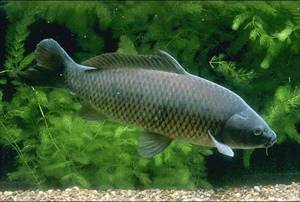
Carp is a domesticated form of carp
Varieties of carp - gallery
Tips for choosing quality fish
- Fresh carp is easier to clean. If you buy fish in a store or market, try to take it from an aquarium. You can kill it with a strong blow to the head at a point located slightly above eye level, or simply by cutting off the head (if you are not going to bake the whole carp). There is a more humane way to kill fish - put it in the freezer for an hour and it will fall asleep.
- If you do not have the opportunity to buy live fish, it is better to choose fresh chilled fish, since frozen fish loses a large amount of minerals when thawing. When purchasing fresh fish, choose a specimen with the head on. This is the only way you can be sure of its freshness.
- Before buying, look into the eyes of the fish: fresh ones should be bright, slightly moist and convex.
- Be sure to inspect the gills and choose a specimen with clean, bright, and red gills.
- The body of fresh fish is quite elastic, without white coating or dried crusts, and the tail should hang freely from the palm.
- When purchasing frozen carp, pay attention to its glaze. If the fish was properly frozen and stored under all necessary conditions, the glaze on it should be smooth, without cracks. If the carp was frozen using dry freezing, then the carcass should be smooth and hard, without ice.
It is best to thaw frozen fish in water at room temperature. To reduce the loss of minerals during thawing, add table salt to the water (7-10 g per 1 liter of water).
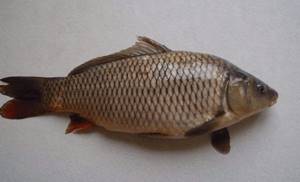
The eyes of fresh fish should be bulging and slightly moist, and the carcass should be elastic, without white coating or dried crusts.
How to painlessly “kill” a fish? | Fisherman's Notes
“How to painlessly kill caught fish?” - this is a question that every fisherman who respects himself and nature asks himself sooner or later. The “catch and release” principle, of course, should also be present in the fisherman. But when a truly trophy specimen is caught (carp, pike, pike perch weighing more than 5 kg, crucian carp from 500-600 g), which simply has nowhere to grow, you don’t really want to release such a fish. And the rules of recreational fishing do not allow such fish to be released. But since man is still a rational being, even if he does not feel sorry for the fish itself, he still needs to think about its freshness after it has suffocated. Therefore, the topic of “painless killing of fish” is becoming increasingly relevant among fishermen.
The Internet is littered with advice on how to “quickly and painlessly kill a fish.” But, unfortunately, among them there are only three tips that deserve at least some attention: a blow to the head with a mallet, rupture of the vertebrae and piercing the brain. Another very good tip is to put the fish in the freezer (in fact, this is what fishermen do, willy-nilly, during winter fishing). We will now consider all these methods. But before you begin to consider methods of euthanasia, you must understand: it is advisable to decide the fate of the caught fish (release it or fry it) within the first hour. If the fish is not killed within the first hour, the quality of its “meat” is already significantly reduced. And if she stays in the cage for more than half a day, then it’s better to just let her go.
There are several options for euthanasia. We will not organize a “hit parade” of them, but simply divide them into good and bad.
Good options:
Option 1. Change your mind and still release the caught handsome fish back into the river. The option is, in fact, the best. Think about what bad thing the fish you just caught did to you? Her only fault is that she decided to look for food in the area of your hook and fell for it. Plus, according to sports fishermen, releasing all the fish you catch is a sign of a true professional. Option 2. Put the fish in the freezer. In essence, we kill two birds with one stone: we painlessly kill the fish with cold and do not allow it to spoil in the sun. Fish, as a cold-blooded creature, when placed in a cold environment, immediately begins to become numb and “fall asleep.” Most fish cannot tolerate such “freezing into ice” and die (the best example: fish caught during winter fishing). After an hour or two, you can remove the fish from the freezer and gut it. True, there are exceptions: crucian carp very easily tolerate freezing into ice, so they need to be killed quickly, while still “dormant” after being frozen. The main disadvantage is that portable refrigerators (compressor auto-refrigerators are ideal for this purpose) are not such a cheap pleasure. In addition, they require a car to operate: they are supplied with power from the cigarette lighter.
Middle to half: Option 3. Hit on the head with a mallet. Today, fishing stores sell special beaters for stunning caught fish. The blow of the mallet is intended only to stun the fish, but in practice, many fish cannot bear this blow and die immediately. The method deserves the right to exist: the beater is light, compact, easily fits in a backpack, always at hand and in combat readiness.
But there are also significant disadvantages. First, the fisherman must have a “steady” hand in order to finish off the fish with one blow (if the hand “shakes”, you will only add to the torment of the fish). And secondly, dead fish must be gutted immediately, while still on the shore of the reservoir, and immediately salted (as before frying). Otherwise, the fish may begin to spoil within a whole day.
Bad options (but without fish...):
Option 4. Vertebral fracture. Essentially you need to break the fish's back. If the angler has a “steady” hand, we do the following: we put our hand under the fish’s gills, grab the vertebra, and sharply turn its head (at this time you need to hold the fish with your other hand). The method is very difficult to implement, and therefore, if you have the slightest doubt about a successful “outcome,” I advise you to refrain from it. If you don’t have enough courage, we do this: we put the knife under the gills, take a stone and confidently hit the knife with the stone (we cut the ridge). In practice, the knife must be very sharp, the stone must be weighty, and the impact of the stone on the knife must be confident. Disadvantages: the fish must be gutted and salted on the shore.
Share link:
Liked this:
Like
Similar
Cleaning and cutting of carp
Currently, a huge number of recipes for cooking carp have been invented. It is baked with a side dish of vegetables, potatoes and cereals, and also boiled with spices, stuffed in various ways and simply fried in vegetable oil until crispy. On store shelves you can find gutted frozen fish, fillets and ready-made semi-finished products. But you'll get the most benefit from fresh or live carp. Don't be afraid of the upcoming hassle with cutting the fish. Having mastered a few simple rules, you can easily turn live carp into a culinary masterpiece.
The most common carp on sale are common and mirror carp. The latter is a little easier to clean, due to the fact that its scales are large and not very tightly pressed to each other. With common carp you will have to tinker a little longer.
What you need for work
To properly and easily clean and cut fish you will need the following tools:
- sharp knife for cutting fish;
- fish scissors;
- scraper for cleaning fish, you can use a spoon.

To make the process of cleaning and cutting carp easier, purchase the necessary tools: a - sharp knife, b - scissors, c - scrapers
You also need to prepare:
- a plastic bag or bucket for bones and other debris;
- thick paper or newspaper;
- work gloves.
Step-by-step instructions for cleaning, gutting and cutting carp
- Cover the table with thick paper or newspaper. The paper will absorb the liquid that the fish will release during cutting and prevent contamination of the workplace. Some housewives prefer to clean and cut fish directly in the sink, after closing the drain with a special silicone or metal mesh.
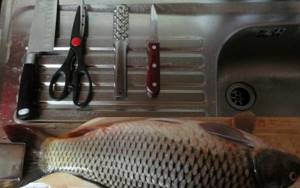
Some housewives clean and cut fish in the sink
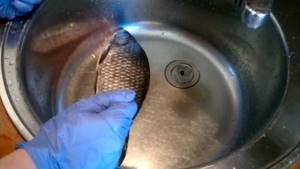
To prevent the fish from slipping out of your hands, wear work gloves
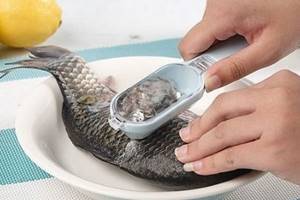
Remove scales using a scraper

Cut the carcass along the belly and remove the entrails

Remove the head or take out the gills
How to skin a whole carp - gallery
How to fillet fish
When cutting carp into fillets, you need to separate the meat from its inedible parts: skin, spine, bones. To do this, it is not necessary to first gut and scale the fish.
- Using a sharp fillet knife, cut along the gills of the fish to the spine, but do not cut through it.
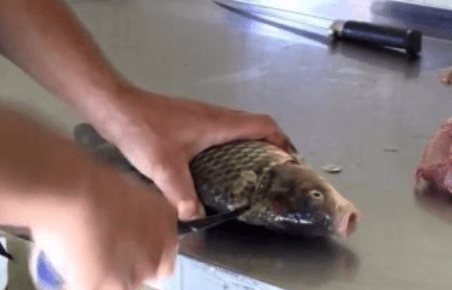
To fillet carp, you need to make an incision along the gills of the fish.
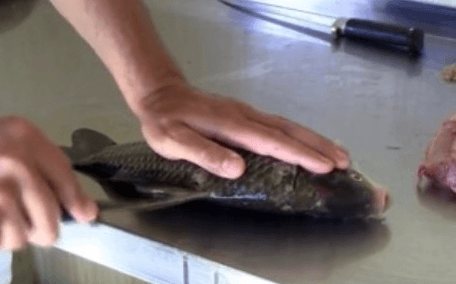
An incision is made from the side of the dorsal fin before the incision along the gills
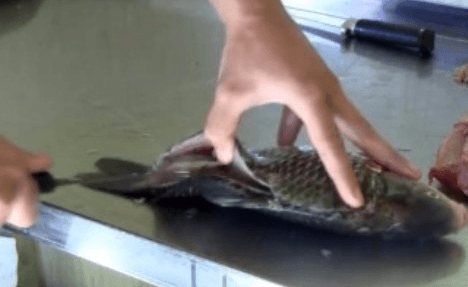
In the tail part of the carp carcass you need to cut through it with a knife
How to kill crucian carp - Catch a fish
Many fishermen have encountered a situation where, after fishing, you bring home crucian carp, and on the threshold, a dissatisfied wife greets you with a categorically rejected look and a no more friendly phrase: “Did you catch fish? Now clean it yourself!” At the same time, you understand that no amount of persuasion or persuasion will help. What to do? Nothing terrible happened. We take on the matter ourselves.
Tools and accessories
To quickly and efficiently clean crucian carp from scales, you will need:
- regular table knife;
- scissors;
- a large amount of water;
- vessel.
If you have to do this a lot and often, use a two-horned fork and a special knife. It comes in different variations, sizes, design features, and can be sharp or blunt. The last option is something like a brush with blunt spikes.
We carry out basic operations with a knife. Scissors are needed to trim the fins so as not to be pricked by them. In water, it is thoroughly washed to remove scales, blood, and other unnecessary residues. The cut up carcasses are placed in a bowl or basin.
How to clean crucian carp from scales
The prey is butchered alive or unconscious. When choosing the second option, she is stunned in the head with the handle of a knife. You can place your meal in the shade, covering the top of the bowl to prevent evaporation and protect it from pets. In a few hours the fish will fall asleep, but will not have time to dry out. It is more humane to start work after this, since she will not feel anything.
The mucus and moisture present on the surface help to quickly remove all excess from our trophy before it gets into the frying pan. But you can do this after rest, after wrapping it in cellophane and putting it in the refrigerator to avoid moisture loss.
First, use a double-horned fork to pin the tail to the board. This is done so that the fish does not slip out of your hands and does not “ride” on the cutting board.
Then we begin the process of removing the scales. Much has been written on the Internet and videos have been shot about how to clean crucian carp and prepare it for frying. Difficulties should not arise even for those who are doing this for the first time. The proposed method of how to clean crucian carp will help you understand the intricacies of this simple matter.
When removing scales, there are no fundamental differences: whether it will be done with a sharp small knife, a large cutting knife, not very sharp, or a completely dull one. By the way, this procedure is freely carried out using the thumbnail instead of this tool.
Cleaning tool
Typically, a standard kitchen knife is used to clean carp. For people who have not encountered this seemingly complex matter, it is better to use a dull knife, spoon or fork. There are also special tools on sale - scrapers for cleaning fish. They are very convenient to use.
You can also use a special grater that you make yourself for this work. Tin beer caps are nailed to a wooden board. A good grater will be made from a tin can with holes in the bottom, punched with a nail.
To free the carcass from scales, it is better to purchase a vegetable peeler with a longitudinal blade. It will make the task easier and make the work quicker. To clean larger and larger specimens, it is better to use the bathroom. The peeler should be separate and used only for cleaning fish.
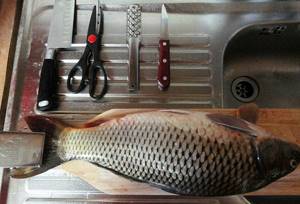
Preparation
First of all, the carp needs to be rinsed under cold water, thoroughly wetting the scales. Then get to work immediately so that the scales do not have time to dry, otherwise the cleaning process will be slow and difficult.
Hard scales that adhere closely to the skin will not be easy to remove. It is better to immerse such fish in boiling water for a few minutes, the main thing is not to overdo it.
To avoid injury from the hard fins during the procedure, they must be removed by cutting them with kitchen scissors.
Fresh fish must be kept in the refrigerator, without leaving it on the table for too long. After purchasing it, you need to immediately remove all the insides and gills, since this is where bacteria multiply. Before placing the carp in the refrigerator, it must be washed and dried with a paper towel.
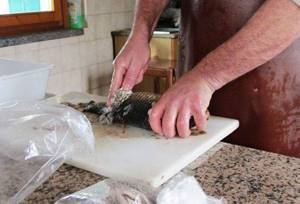
How to clean fish from scales?
The main question that arises in the process of processing carp is what to do to prevent the scales from flying off in different directions?
- Many people clean fish by dipping it in a bowl of water. The scales remain in the water and do not need to be removed later.
- You can put the carcass in a thick plastic bag and clean it there. All waste will remain inside the bag.
- The carcass can be cleaned on the table by nailing it by the tail to a wooden cutting board. The fish is pulled out, held by the head, and calmly cleaned, starting from the tail, against the growth of the scales. However, after this procedure you will have to wash the table and kitchen utensils.

Carp processing process
- After the cleaning process, the fish must be gutted. The carcass is placed belly up and opened with a sharp knife from head to tail.
- Then all the entrails and the brown film inside the abdomen are removed. Depending on the type of future dish, the head of the fish is either removed completely or the gills are pulled out of it.
- The fish is thoroughly washed and the preparation of the dish begins.
- After finishing the treatment process, the surface of the kitchen table and all kitchen utensils must be thoroughly washed with a cleaning agent, or better yet, scalded.
Fresh carp is easier to clean. Having brought home a fish you bought or caught with your own hands, you should not put it in the freezer; it is better to immediately begin this not very pleasant, but necessary process.
We recommend reading the following article: how to clean trout
Removing gills from crucian carp
If you are not going to cut off the head, then before the crucian carp gets into the frying pan, you need to remove its gills. For this purpose, we cut off the jumper connecting the body and head of the fish. Next, we pick them up with the tip of the knife, supporting them with our thumb, and simply pull them out. We wash everything generously with water.
If you like a dish made from fish halves rather than eating the whole fish, we cut it in a different way:
- We clean the fish from scales in the same order;
- we cut off all the fins with scissors to prevent the possibility of being pricked by them;
- Along the spine, starting from the tail to the head, with the tip of a knife we cut through the flesh to the rib bones.
Next, we cut the rib bones at the places where they join the ridge in the reverse order - from head to tail. If the specimen we are working with is large, we can use a garden tool (secateurs) or a large and heavy cutting tool. Secateurs are a pleasure to work with. It can cut large bones without effort. The blunt end of the pruner's claw, which enters the belly of the crucian carp, allows you not to worry about it touching and damaging the gallbladder. After this, we run a knife along the flesh at a distance of 2-3 centimeters from the caudal fin from top to bottom. Then you can move the two separated halves of the crucian carp apart, as if opening a box; - We remove all internal organs. If there is caviar, put it back;
- cut off the head and, if necessary, the tail.
This method is preferable because large specimens can be cut very quickly. It is important to wash them well in water. These halves of the carcass are better fried and are more convenient to eat. To prevent the smell of dampness, add a little vinegar to the water.
We hope that now the question “how to easily clean crucian carp for frying” will not confuse you after a successful fishing trip.
From the video you will learn how to quickly and easily clean crucian carp:
Source: promysel.com
Thanks to the author of the post in prakuking: he touched on a topic that has been bothering me for a long time - how to kill live fish as quickly and painlessly as possible.
This topic worries me not so much because of the taste and texture, which, of course, will be much better in fish killed quickly without much pain, but... well, I can’t just be a “pussy cook” - I really love meat, I really love fish, I am not going to give up consuming them, but at the same time I very clearly understand that steaks and fillets do not grow on trees. Therefore, the approach is closer to me: if they killed a living creature, then I’ll eat it clean, down to the horns and hooves (and fish ones too, yeah), and not just the tenderloin. And, since I have to kill, I want to have the awareness that I am cutting a living organism, and not a “product,” that is, to bear full responsibility for what I do. And within the framework of this responsibility, I want to quickly end the creature’s torment. In addition, the taste will benefit if the slaughter is carried out quickly and with minimal stress for the animal.
Ike Jime is a Japanese method of quickly killing fish. First, the brain of a still living fish is killed with a quick and targeted blow, after which it does not feel pain. The central nerve canal is then destroyed, which relaxes the muscles.
I will still figure out this method (at the moment, having reviewed a little information, I cannot accurately localize the location of the brain, well, so as to kill it with one blow). But I’ll throw in a couple of links and videos here so you can figure it out later:
a couple of theoretical links to the ike press method and a few more methods:
ike zhime theory indicating specific points other methods another selection with text and videos
You can search for videos in Japanese using this query: 活け締め
Several videos in French and English
Source: kashevarya.livejournal.com


